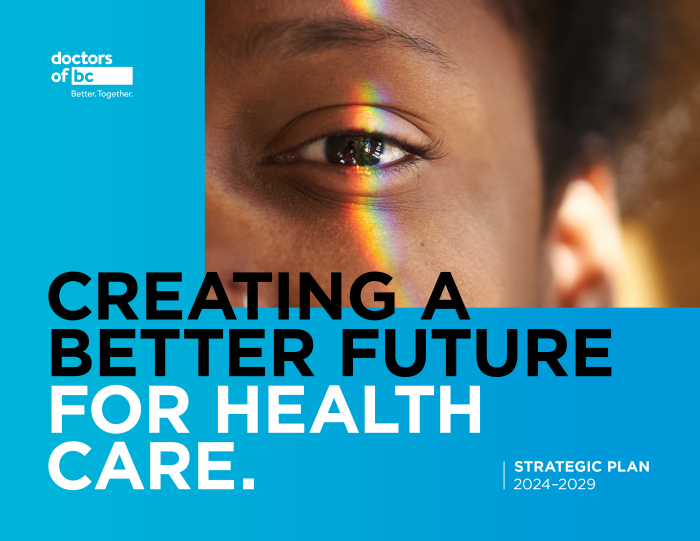- Managing your Practice
-
- Your Benefits
-

Introducing the ultimate Club MD experience
From work to play, and everything in between, we provide you with access to hundreds of deals from recognizable, best-in-class brands, elevating every facet of your life – from practice supports to entertainment, restaurants, electronics, travel, health and wellness, and more. Your Club MD membership ensures that these deals are exclusive to you, eliminating the need to search or negotiate.
Welcome to the ultimate Club MD experience. Your membership, your choices, your journey.
-
- Advocacy & Policy
-
- Collaboration
- News & Events
-

Stay Informed
Stay up to date with important information that impacts the profession and your practice. Doctors of BC provides a range of newsletters that target areas of interest to you.
Subscribe to the President's Letter
Subscribe to Newsletters
-
- About Us
-

Safe Access in BC: Breaking down drug barriers to save lives
September 18, 2020
President's Blog
One of the more challenging aspects of my role as Doctors of BC President has been the media representation of current issues facing our profession. I appreciate our engaged membership that help keep me informed through communication of issues and suggested solutions. Many of you know, I regularly reach out directly to discuss your concerns. Yet, despite more than a year of experience in this arena, I am still occasionally blindsided by reporters.
The most recent occurrence was on CBC’s Early Edition, regarding the expansion of Registered and Psychiatric Nurses now authorized to prescribe safe alternatives to toxic, illicit drugs, in an attempt to address our opioid crisis. We all recognize the need to address this crisis, and the need for increased harm reduction.
I discussed my support of the safety measures proposed by Minister Judy Darcy and issued by Dr Bonnie Henry. How could we as a profession not be wholly supportive of actions likely to save lives? People continue to die every day of overdose despite other remedies, such as funded Naloxone kits, the Lifeguard cell phone app, individual supply testing, and limited prescription access to safer alternatives. More must be done.
What I was not prepared for, was the assertion that physicians were not part of the solution, because many did not want to prescribe, or had ceased prescribing, opioids. These remarks from a physician colleague on the show made me feel defensive. But, there was no way to rebut this allegation because it was factual. I took a step back after the interview to reflect.

Reflecting on the changing perception of opioids
Many of us in practice for the last three decades have seen shifts in opioid prescribing. Initially, I was taught to limit prescription amounts and eligibility to short-term only. “People just have to live with pain,” they said. Governing bodies restricted who could prescribe which controlled substances, tracking those prescriptions for verification of origin. We were always wary.
During those years, it was heartbreaking to see my many patients struggling with chronic pain, with few alternatives for relief. But chronic pain is now considered a modern-day plague, and over the years industry marketing changed in response – we were told opioids were not the enemy, that they could be safely prescribed for longer periods for those in chronic pain. This was “good news” for our patients, with increasing amounts of opioid prescriptions to follow. As opioids were prescribed for acute and chronic pain, dependency, tolerance, and diversion of prescriptions grew. Physicians were under much pressure, not all of it legitimate, to prescribe these medications so patients could “safely” live a better quality of life, freed from their pain.
There was, of course, a darker under recognized issue brewing. Opioids were on the rise as a street drug of choice. Diverted medications contributed to the increasingly easy availability of recreational opioids. Importing illicit drugs and related violence was also rising. While I refuse to blame prescription medications (and the doctors who prescribed them) as the sole driver behind these issues, to ignore the role of these medications completely would not be factual. One of my patients actually told me if I didn’t prescribe his medication, he would have no choice but to buy some from dealers in front of my office – but there was no guarantee, of course, what he would get. Physicians were really over a barrel.
Turning tides: tough regulations and patient care challenges
Enter the professional regulatory bodies. In an aggressive attempt to stem the flow of diverted prescription medications and limit those at risk, many colleges tightened their professional standards around opioid prescribing . Suddenly, physicians previously seen as seeking to limit their patient’s suffering were cast as over-prescribers. The problem was perceived as a lack of knowledge, on behalf of physicians, about the hazard of prescribing opioids and treating chronic pain. One of my colleagues, who was called to task on this issue, said he attended re-training and felt he was now “fully rehabilitated.” I have attended educational meetings and presented many of my most challenging cases. Physicians undergo practice reviews, which include a print out of every controlled substance we have prescribed. I remember looking at my list with the assessor, wondering what it would feel like examining a similar list for antibiotics, hypertensives, or statins? Each encounter, left us with the sense that our licence to practice medicine was on the line. Many felt the safest approach was to simply stop – little chance of getting into trouble with the college, when you are not prescribing the target medications. Unfortunately, deaths continued to climb.
Patients addicted to prescription and street drugs were also caught in the middle. Patients wanting access to long-acting medications to end their addictions, had limited choices. Not every provider was licenced to prescribe these medications. Many were subjected to daily dispensing rules that made their lives even more challenging. I recall discussing opioid addiction options with a young woman I had known her whole life. She had been researching suboxone, and felt it could work for her. I was not able to prescribe the medication, and due to limited access to addiction medicine, she had to wait six whole months before she could begin treatment, set recovery goals, and resume her life.
COVID-19: Highlighting BC’s overdose epidemic
While authorization to prescribe safer alternatives has ultimately increased for physicians, and oversight has became more reasonable, the prescribing culture remains tainted. Increased outreach for screening and education began, and we saw the establishment of treatment across the province that mimics opioids in an effort to reduce opioid dependency. Although people were still dying, the numbers of overdose deaths before COVID-19 was falling. But with COVID-19 upon us, solo drug use has increased and access to usual supply chains has decreased, leaving increasingly toxic drugs tainted with Fentanyl and Carfentanyl readily available. And so, the daily deaths increased once more.
Where do we go from here?
Physicians understand the need for enhanced harm reduction actions to save lives, but we cannot do this alone. The past is the past. We need to look forward if we are going to succeed in reducing overdose deaths. We must rebuild our confidence in prescribing practices to meet this goal.
We need the support of our governing bodies and the public. Now is the time to end the stigma, break down all access barriers to safe supply, and save lives. These enhanced prescribing privileges are just the beginning. Once those struggling with substances have options, we can begin the journey toward addressing the many social determinants of health they need to lead a meaningful life of their own choosing.
- Dr Kathleen Ross




